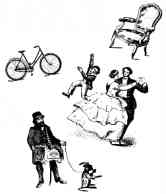 HISTORY'S GREAT
HISTORY'S GREATCOMPUTER
ECCENTRICS
by Marguerite Zientara
Marguerite Zientara is East Coast senior writer for InfoWorld.
Geniuses are often strange, and the geniuses of the computing field are no exception. Though one or another of these characters might seem downright peculiar to us today, it was their ability to see the unseen and ignore others' opinions that opened the way to the computer age.

BLAISE PASCAL (1623-1662)
French philosopher Blaise Pascal, inventor of the first workable automatic
calculator, was strange right from day one. In his first year, according
to the available literature, he was inclined to give way to hysterics at
the sight of water. He was also known to throw tantrums upon seeing his mother
and father together. Arriving at the logical conclusion for their day, the
adults in charge tried to exorcise him from a sorcerer's spell.
In time, Blaise managed to calm himself down and settle
into a respectable infancy. At the age of four he suffered the untimely
death of his mother, and it was then that Etienne Pascal took over his son's
education. This was both good and bad. Etienne's rather uncompromising ideas
encouraged the mental discipline Blaise would need for his later accomplishments,
but they almost smothered his mathematical pursuits.
From the start, Blaise was curious about geometry. His
father, a talented mathematician in his own right, wanted him to study Greek
and Latin first. Locking up all his math books, he warned his friends never
to mention mathematics in front of his son. In the end Blaise managed to
beg from Etienne the most elementary definition of geometry, whereupon he
taught himself its basic axioms-and succeeded, with no guidance whatever,
in proving the Thirty-Second Proposition of Euclid. This was enough to convince
his father, who set about teaching him everything he knew about geometry.
When Blaise was sixteen, Etienne accepted a government
post that called for monumental calculations in figuring tax assessments.
The man who had tried to hold back his son now turned to him for help in
the thankless labor of hand-totaling endless columns of numbers. Blaise soon
formulated the concept for a new calculating machine, then spent eleven years
trying to perfect it. Just before he turned thirty, and after building more
than fifty unsuccessful models, he introduced a working mechanical calculator.
The Pascaline caused a sensation on the Continent (this
despite the fact that it could only add and subtract), but Blaise was unable
to find buyers for his wondrous machine. People said it was too complicated
to operate, sometimes made mistakes and could be repaired only by its inventor.
They also feared it would take jobs away from bookkeepers and other clerks.
After all those years of work, the gadget was a commercial flop.
In 1654, after a profound religious experience, Pascal
renounced the world and all the people in it. Though his contributions to
math and science include the modern theory of probability, advances in differential
calculus and hydraulics, he went on to become one of the greatest mystical
writers in Christian literature. Still, some of his religious views-the
bet on God's existence, for example-grew out of his mathematical insights.
He lived to the age of thirty-nine, when he died of a brain hemorrhage.

GOTTFRIED WILHELM LEIBNIZ (1646-1716)
Sometimes the race goes to the runner-up, not to the man who finishes first.
Case in point: Gottfried Wilhelm Leibniz, who developed a calculator even
better than Pascal's (it could add, subtract, multiply and divide) and went
on to make a killing in the marketplace. Not that he was just in it for
the money: "For it is unworthy of excellent men to lose hours like slaves
in the labor of calculation," he wrote, "which could safely be relegated
to anyone else if machines were used."
While studying for a law degree, Leibniz became curious
about a secret society that claimed to seek the "philosopher's stone." Something
of a wag at twenty, and not above practical jokes, he collected the most
obscure phrases he could find in the alchemy books and composed a nonsensical
letter of application. The society was reportedly so impressed by Leibniz'
erudition that they not only accepted him for membership, but appointed him
their secretary as well.
Leibniz was clever, but he was also overwhelmingly versatile.
Regarded as one of the great universalists of all time, he made his mark
in such diverse areas as law, history, nautical science, optics, hydrostatics,
mechanics, mathematics and political diplomacy. His binary theory and initiation
of symbolic logic laid the foundation for today's computers.
How did the man do so much? First of all, he lived for
seventy years, almost twice as long as Pascal. Second, it is said he could
work anywhere, at any time and under any conditions. He read, wrote and
ruminated incessantly. By all accounts he slept little but well-even during
the nights spent more or less upright in his chair, where he'd remain for
days at a time until he finished the project at hand.
With all these working hours, one might suspect that
Leibniz was something of a hermit. Not so. He enjoyed socializing with all
kinds of people, believing that he could learn from even the most ignorant.
According to his biographers, he spoke well of everyone and made the most
of every situation. Which would explain his notorious theorem of optimism-"Everything
is for the best in this best of all possible worlds"-later satirized by
Voltaire in the novel Candide.
In his last years, however, that celebrated optimism
undoubtedly faded as his fame declined and those close to him gradually slipped
away. When he died in 1716, during an attack of gout, only his secretary bothered
to attend the burial.
| THE PASCALINE AND THE LEIBNIZ
CALCULATOR Blaise Pascal's pioneering calculator was essentially a two-dimensional machine, using cogged wheels rotated in proportion to numerical values that were added or subtracted. Multiplication or division had to be accomplished by tedious repetition of these operations. Leibniz' calculating machine was an improvement in three dimensions, using wheels at right angles that could be displaced by a special stepping mechanism to perform rapid multiplication or division. 
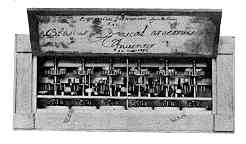 Inside the Pascaline.
Inside the Pascaline.
The inner workings of Leibniz' calculator. |
CHARLES BABBAGE (1792-1871)
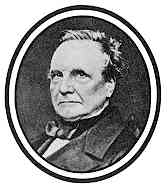
Mired in the nineteenth century but devoted to an idea that would revolutionize
the world after his death, Charles Babbage was a man who knew his own worth
and his own genius.
Undaunted by the failure of early inventions (among
them, shoes for walking on water), he proceeded to work on his Difference
Engine. This sophisticated mechanical calculator would preoccupy him for
twenty years, during which he managed to convince the Chancellor of the
Exchequer to lend financial support and became the first recipient of a
government grant for computer science. Following a nervous breakdown and
other major crises, in 1833 he gave up on the machine, then conceived an
even more grandiose scheme.
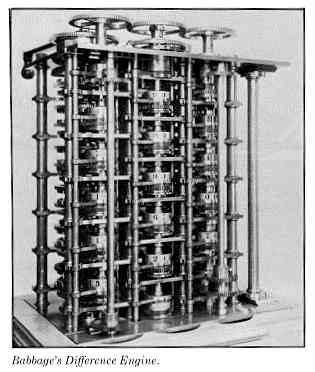
For the rest of his life Babbage would attempt to construct
his Analytical Engine, a mechanical device that would have included most
of the essential features of modern digital computers: a central processing
unit, software instructions, memory storage and printed output. He spent
years making detailed drawings, inventing machine tools and actually trying
to build his machine-only to concede finally that his concept was way beyond
the technology of the time.
Most people thought he was crazy to spend so much time
and money on an obviously absurd idea (even the British government kept
withdrawing its support), but in fact the Analytical Engine was just one
of Babbage's myriad concerns. Fortunate enough to have been born into wealth,
he enjoyed the luxury of time to follow his many other interests: consulting
for railroad pioneers, devising a mail delivery system based on wires strung
between towers to carry containers of mail, and inventing a lighthouse flashing
system and a submarine. He also had the distinction of being able to pick
any lock.
Yet the government positions and honors Babbage felt
were his due constantly eluded him. These disappointments and slights led
to deep bitterness, revealed in his oft-quoted observation that he had never
had a happy day in his life. A friend of his wrote: "He spoke as if he hated
mankind in general, Englishmen in particular and the English Government
most of all."
Part of Babbage's proclaimed unhappiness undoubtedly
came from his notorious feud with London's organ grinders, then estimated
to number a thousand, whom he tried to silence with a court action. In retaliation,
the organ grinders came from miles around to play their noisy instruments
in front of his home, at times joined by street punks who tossed dead cats,
blew bugles at him and smashed his windows. Jeering children followed him
around, as did bands of hecklers-sometimes as many as a hundred at a time,
shouting threats to overturn the cab he was riding in or to burn down his
house.
Still, idiosyncrasies and all, Babbage was considered
a fascinating companion. He was a witty and sought-after dinner guest and
often hosted parties for two or three hundred people. Among his friends
were the most notable scientific, political and literary figures of the
day, including Charles Dickens.
One of his most intriguing friendships was with Lady
Ada Augusta Lovelace, the only daughter of Lord Byron. A beautiful and charming
woman, Lady Lovelace was the same age Babbage's deceased daughter would
have been. The widower Babbage and Lady Lovelace, who had been brought up
without her father, enjoyed a close, mutually rewarding relationship until
her death at age thirty-six. Babbage himself died at seventy-nine, with
only one mourner besides the family group at the funeral. At the end he
was considered to have been a failure with an unworkable idea. Yet on the
moon, which computers enabled man to reach, is a crater named for Charles
Babbage. And the Royal College of Surgeons in England has preserved the brain
of this man who lived before his time.
ADA LOVELACE: THE FIRST COMPUTER PROGRAMMER

Ada! Wilt thou by affection's law,
My mind from the darken'd past withdraw?
Teach me to live in th future day ...
-Lord Byron
Today's computer programmers are clever indeed,
but few could hold a light-emitting diode to Augusta Ada Lovelace in terms
of creativity. She saw the art as well as the science in programming, and
she wrote eloquently about it. She was also an opium addict and a compulsive
gambler.
As the only legitimate offspring of Lord Byron, Ada
would have been a footnote to history even if she hadn't been a mathematical
prodigy. Though Byron later wrote poignantly about his daughter, he left
the family when she was a month old and she never saw him again. Biographers
tend to be rather hard on Ada's mother, blaming her for many of her daughter's
ills. A vain and overbearing Victorian figure, she considered a healthy
daily dose of laudanum-laced "tonic" the perfect cure for Ada's nonconforming
behavior.
Ada was well tutored by those around her (British logician
Augustus De Morgan was a close family friend), but she hungered for more
knowledge than they could provide. She was actively seeking a mentor when
Charles Babbage came to the house to demonstrate his Difference Engine for
her mother's friends. Then and there, Ada resolved to help him realize his
grandest dream: the long planned but never constructed Analytical Engine.
Present on that historic evening was Mrs. De Morgan, who wrote in her memoirs:
If Babbage was the force behind the hardware of the
first protocomputer, Ada was the creator of its software. As a mathematician,
she saw that the Analytical Engine's possibilities extended far beyond its
original purpose of calculating mathematical and navigational tables. When
Babbage returned from a speaking tour on the Continent, Ada translated the
extensive notes taken by one Count Manabrea in Italy and composed an addendum
nearly three times as long as the original text. Her published notes are
particularly poignant to programmers, who can see how truly ahead of her
time she was. Prof. B. H. Newman wrote in the Mathematical Gazette that
her observations "show her to have fully understood the principles of a
programmed computer a century before its time." Among her programming innovations
for a machine that would never be realized in her lifetime were the subroutine
(a set of reusable instructions), looping (running a useful set of instructions
over and over) and the conditional jump (branching to specified instructions
if a particular condition is satisfied).
While the rest of the party gazed at this beautiful instrument with
the same sort of expression and feeling that some savages are said to have
shown on first seeing a looking glass or hearing a gun, Miss Byron, young
as she was, understood its workings an saw the great beauty of the
invention.

Ada also noted that machines might someday be built
with capabilities far beyond the technology of her day and speculated about
whether such machines could ever achieve intelligence. Her argument against
artificial intelligence in "Observations on the Analytical Engine" was immortalized
almost a hundred years later by Alan M. Turing, who referred to this line
of thinking as "Lady Lovelace's Objection." It is an objection often heard
in debates about machine intelligence. "The Analytical Engine," Ada wrote,
"has no pretensions whatever to originate anything. It can do whatever we
know how to order it to perform."
It is not known how or when Ada became involved in her
clandestine and disastrous gambling ventures. Unquestionably, she was an
accomplice in more than one of Babbage's schemes to raise money for his Analytical
Engine. Together they considered the profitability of building a tic-tac-toe
machine and even a mechanical chess player. And it was their attempt to develop
a mathematically infallible system for betting on the ponies that brought
Ada to the sorry pass of twice pawning her husband's family jewels to pay
off blackmailing bookies.
Ada died when she was only thirty-six years old, but
she is present today in her father's poetry and as the namesake of the government's
newest computer language. In the late 1970s the Pentagon selected for its
own a specially constructed "superlanguage," known only as the "green language"
(three competitors were assigned the names "red," "blue" and "yellow") until
it was officially named after Ada Lovelace. Ada is now a registered trademark
of the United States Department of Defense.
HOWARD RHEINGOLD

IN THE CARDS The use of punch cards in computers was devised by Charles Babbage, who adapted the automated textile loom invented in 1805 by Frenchman Joseph Marie Jacquard. The Jacquard pasteboard cards had holes punched out of them to allow only certain threads to be grasped by the rods that did the weaving. In Babbage's computer, moving rods would decipher two sets of cards: one to designate the operations to be performed, the other for the variables on which they were to operate. Punch cards would remain in widespread use until the development of fast, reliable magnetic mass storage media in the 1960s. 
|
ALAN M. TURING (1912-1954)

One of the great abstract thinkers of this century, Alan M. Turing was
another eccentric who started out as an extremely gifted student. As early
as age nine, he reportedly startled his mother by asking questions like
"What makes oxygen fit so tightly with hydrogen to produce water?"
By the time he reached Cambridge University, Turing
was already known for his unorthodox ways. When setting his watch, he did
not simply ask someone the correct time but instead observed a specific
star from a specific locale and mentally calculated the hour. He jogged long
distances in a time when this was considered odd, and he thought nothing
of riding his bicycle twelve miles through a rainstorm at night to keep
an appointment. (When his bicycle chain was skipping, instead of fixing
the chain he correctly calculated the exact moment of each skip and pedaled
accordingly.)
While some might describe his methods as doing things
the hard way, for Turing they were merely a game. The first proof of his
brilliance came in 1936, when at the age of twenty-four he published his
paper "On Computable Numbers, with an application to the Entscheidungsproblem."
In this major contribution to computing theory, Turing presented a landmark
theorem in mathematical logic in terms of an idealized computing machine.
He posited that a "Universal Turing Machine" could embody any logical procedure
as long as it was given appropriate instructions. A decade before the first
practical computer, he described its essential characteristics.
Turing's findings were regarded by some as proof that
human intelligence is superior to machine intelligence, but this was not
his idea at all. In his essay "Can a Machine Think?" published in the mid-1940s,
he wrote: "We too often give wrong answers to questions ourselves to be
justified in being very pleased at such evidence of fallibility on the part
of the machines." His essay also contained the notion that "there might be
men cleverer than any given machine, but, then again, there might be other
machines cleverer again, and so on."
During World War II Turing was one of a team of British
scientists sequestered at the lovely Bletchley Park estate and ordered to
develop machinery that could decipher codes from Germany's Enigma encoding
machines. The results of these efforts, often credited with a decisive role
in winning the war, were the electromechanical machines nicknamed Heath
Robinson (after the 1930s cartoonist of the Rube Goldberg school), Peter
Robinson, the Robinson and Cleaver (both named after London stores) and
the Super Robinson. The successor to these machines, the Colossus 1, is
recognized as one of the first electronic computers. Turing went on to help
design the Automatic Calculating Engine (ACE) Pilot computer and later worked
on the Manchester Automatic Digital Machine (MADM), one of the earliest stored-program
computers. In 1951 and 1952 he took part in radio debates on the computer's
ability to think.
Arrested in 1952 for "gross indecency," Turing was subjected
to hormone injections that rendered him impotent. His homosexuality was
considered a security risk at the height of the cold war. His last extraordinary
act was to kill himself, in 1954, at the age of forty-two. Whether on purpose,
as the coroner ruled, or accidentally, as many believed, he died of poisoning
from potassium cyanide.
CRACKING THE NAZI CODE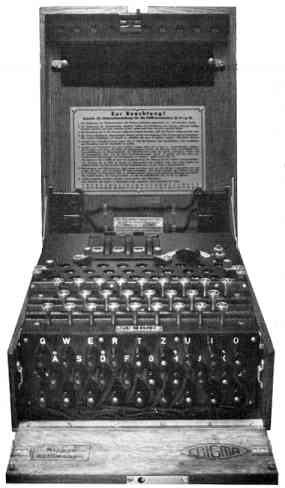 The Enigma code machine (left) gave the Nazis a decided advantage
in the early days of World War II by keeping German front-line communications
undecipherable to the Allies. Though one of the first of these machines
was captured and its messages decoded by the Poles, subsequent improvements
in Enigma's design-incorporating frequent changes in the keys by which characters
were enciphered-rendered its output a deadly mystery.
The Enigma code machine (left) gave the Nazis a decided advantage
in the early days of World War II by keeping German front-line communications
undecipherable to the Allies. Though one of the first of these machines
was captured and its messages decoded by the Poles, subsequent improvements
in Enigma's design-incorporating frequent changes in the keys by which characters
were enciphered-rendered its output a deadly mystery.The British government hoped to break the codes through high-speed automated transposition of ciphered characters to find their underlying patterns. Eventually these efforts led to the construction of the Colossus 1 (pictured below). The machine was cloaked in secrecy; after helping to crack the code and revealing invaluable information that hastened the Allies' victory, it was dismantled for reasons of security. The only known surviving part is the paper tape feeder wheel (shown here), used for many years as a paperweight before being donated to the Computer Museum in Boston. 

|
MODEL ONE: THE FIRST MODERN BINARY COMPUTER
Non-eccentrics have also made their mark on the history of computers. In February 1983, forty-five years after he developed the world's first binary computer, Dr. George Stibitz was finally recognized by his peers and invited to join the National Inventors Hall of Fame. At the time of his induction, he was hard at work on four different major projects at Dartmouth Medical School in Hanover, New Hampshire.
Dr. Stibitz constructed his machine to solve a manpower problem at Bell Laboratories. In 1937 the phone company had begun to rely on complex numbers in the equations that computed characteristics of filters and transmission lines. Thirty people worked full time at the impossible task of performing these computations on large, bulky desk calculators, the only tools available that could work with i, the square root of minus one.
Looking for a more efficient way to get the job done, Stibitz experimented at home with the concept of building a calculator that would automatically solve complex arithmetic problems with binary computations. The most convenient parts available were the old-fashioned electromechanical telephone relays: because they could be switched either on or off to represent 0s and 1s, the relays were ideal for performing binary calculations. Satisfied that his concept would work, Stibitz convinced his boss to build a full-scale working model.

By 1939 the Model One went into operation, chopping
off two-thirds of the time needed to solve the equations. The machine consisted
of two large banks of telephone relays, each bank measuring eight feet in
height, five feet across and a foot thick. Each relay was five inches long
and one and a half inches wide. The left bank handled the complex values,
while the right bank juggled the integer numbers. Then the two banks were
integrated for the final solution. The fact that it held only 32 bytes of
memory (1/32K), and that it cost a whopping $20,000 to build, took nothing
away from its success.
Bell went on to build bigger and better versions of
the relay-based computer, but this technology was dated almost as soon as
it was assembled. Relay-based computers were more reliable than vacuum-tube-blowing
behemoths like ENIAC, but the relays were outclassed in calculating speed
by about 500 to 1.
All of today's computers can trace their roots back to
Stibitz' talent and imagination. His binary computer, U.S. Patent No. 2,668,661
issued in 1939, now takes its place next to other great American inventions
like the Model-T, the cotton gin, the electric light and the Wright brothers'
plane.
ROE R. ADAMS III
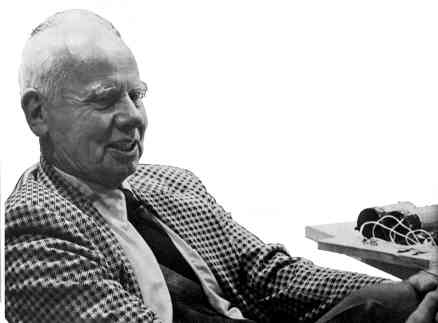
George Stibitz with his first binary adder.
Return to Table of Contents | Previous Article | Next Article

